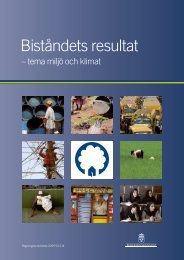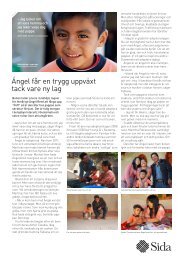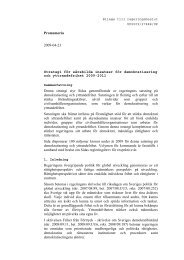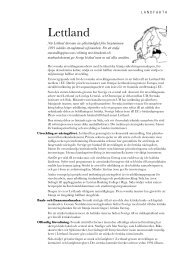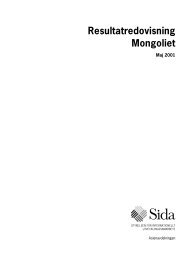Mobilisation of the Poor – a means to Poverty Reduction? - Sida
Mobilisation of the Poor – a means to Poverty Reduction? - Sida
Mobilisation of the Poor – a means to Poverty Reduction? - Sida
Create successful ePaper yourself
Turn your PDF publications into a flip-book with our unique Google optimized e-Paper software.
In summary, <strong>the</strong> evidence reviewed in this chapter reveals that <strong>the</strong> key CAP achievements with<br />
regard <strong>to</strong> empowerment are raising awareness <strong>of</strong> and creating a sense <strong>of</strong> unity and mutual concern<br />
among <strong>the</strong> poor in general and women in poor rural households in particular. The programme’s<br />
achievements in enhancing <strong>the</strong> bargaining power <strong>of</strong> <strong>the</strong> poor are limited <strong>to</strong> some selected instances<br />
where CAP helped collectively mobilise small producers. As regards poverty reduction, <strong>the</strong> key<br />
positive outcomes are <strong>the</strong> institutionalisation <strong>of</strong> group savings as a <strong>means</strong> <strong>to</strong> promote livelihood<br />
security, <strong>the</strong> diversification <strong>of</strong> potential avenues <strong>of</strong> borrowing for consumption and production<br />
purposes, and <strong>the</strong> creation <strong>of</strong> a social network (social capital) within which mutual support is readily<br />
available, particularly at times <strong>of</strong> distress. However, <strong>the</strong>re is a host <strong>of</strong> findings that indicate that <strong>the</strong><br />
impact <strong>of</strong> CAP in respect <strong>of</strong> empowerment or poverty alleviation should not be overstated. Limited<br />
perceived impact in regard <strong>to</strong> social justice objectives, social division <strong>of</strong> labour within <strong>the</strong><br />
household, and reduction <strong>of</strong> domestic violence, <strong>the</strong> continued importance <strong>of</strong> moneylenders and<br />
retail traders as sources <strong>of</strong> credit even among CAP households, and <strong>the</strong> limited success in<br />
employment generation are among <strong>the</strong> fac<strong>to</strong>rs that point <strong>to</strong> a low impact <strong>of</strong> CAP. Bearing in mind<br />
that <strong>the</strong>se are difficult goals <strong>to</strong> achieve given <strong>the</strong> complex structural nature <strong>of</strong> <strong>the</strong> problems<br />
involved, it would be unrealistic <strong>to</strong> expect that one single programme or one single approach could<br />
address <strong>the</strong>m all, however comprehensive that programme or approach may be. The high<br />
participation <strong>of</strong> women in CAP activities at <strong>the</strong> grassroots level does indicate that some social<br />
change has been brought about by CAP. Through CAP women have identified and developed a<br />
social space that builds on <strong>the</strong> traditional openings for <strong>the</strong>m in sec<strong>to</strong>rs such as seettu and, at <strong>the</strong> same<br />
time, increases <strong>the</strong>ir involvement in <strong>the</strong> “public sphere”, from which <strong>the</strong>y have been more or less<br />
excluded, particularly in rural society. This may be seen as a significant and notable change from<br />
<strong>the</strong> angle <strong>of</strong> empowerment <strong>of</strong> women. On <strong>the</strong> o<strong>the</strong>r hand, <strong>the</strong> inadequate presence <strong>of</strong> women in<br />
key decision-making positions in <strong>the</strong> higher echelons <strong>of</strong> <strong>the</strong> CAP organisational structure reveal that<br />
change has been limited and slow.<br />
On <strong>the</strong> whole, <strong>the</strong>re are several positive lessons that can be drawn from CAP experience with<br />
regard <strong>to</strong> <strong>the</strong> potential <strong>of</strong> <strong>the</strong> social mobilisation approach as a <strong>means</strong> <strong>to</strong> safeguard <strong>the</strong> poor and<br />
enhance <strong>the</strong>ir comparative advantages within a framework <strong>of</strong> market-led growth. We will return <strong>to</strong><br />
this <strong>the</strong>me in <strong>the</strong> next chapter.<br />
40<br />
MOBILISATION OF THE POOR <strong>–</strong> A MEANS TO POVERTY REDUCTION <strong>–</strong> <strong>Sida</strong> EVALUATION 02/08




